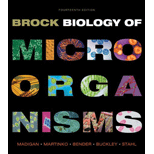
The genus of Halobacterium consists of several species of Archaea with an aerobic
Explanation of Solution
Halobacterium is an extreme halophilic Archaea that live in high salt environments. This extremely halophilic Archaea need large amounts of NaCl for the growth. However, the cells of Halobacterium require both potassium and NaCl for growth because both play an essential role in maintaining osmotic balance. This organism must either synthesis or accumulate solutes intracellularly and these solutes are called as compatible solutes. These compatible solutes help the cell to maintain a positive water balance with their surroundings. Halobacterium synthesis or import compatible solutes to prevent the plasmolysis.
Halobacterium neither
Escherichia coli is a gram negative, rod shaped, and facultative anaerobic bacterium. Escherichia coli has gram-negative cell wall that provides structural integrity to the cell. Cell wall also protects the cell from the internal turgor pressure that caused due to much higher concentration of proteins and other molecules present inside the cell in comparison to external surroundings. The cellular components and proteins of E.coli are not structurally adapted for survival in high salt environments and it cannot accumulate or synthesis compatible solutes.
Want to see more full solutions like this?
Chapter 16 Solutions
Brock Biology of Microorganisms Plus MasteringMicrobiology with eText -- Access Card Package (14th Edition)
 Human Anatomy & Physiology (11th Edition)BiologyISBN:9780134580999Author:Elaine N. Marieb, Katja N. HoehnPublisher:PEARSON
Human Anatomy & Physiology (11th Edition)BiologyISBN:9780134580999Author:Elaine N. Marieb, Katja N. HoehnPublisher:PEARSON Biology 2eBiologyISBN:9781947172517Author:Matthew Douglas, Jung Choi, Mary Ann ClarkPublisher:OpenStax
Biology 2eBiologyISBN:9781947172517Author:Matthew Douglas, Jung Choi, Mary Ann ClarkPublisher:OpenStax Anatomy & PhysiologyBiologyISBN:9781259398629Author:McKinley, Michael P., O'loughlin, Valerie Dean, Bidle, Theresa StouterPublisher:Mcgraw Hill Education,
Anatomy & PhysiologyBiologyISBN:9781259398629Author:McKinley, Michael P., O'loughlin, Valerie Dean, Bidle, Theresa StouterPublisher:Mcgraw Hill Education, Molecular Biology of the Cell (Sixth Edition)BiologyISBN:9780815344322Author:Bruce Alberts, Alexander D. Johnson, Julian Lewis, David Morgan, Martin Raff, Keith Roberts, Peter WalterPublisher:W. W. Norton & Company
Molecular Biology of the Cell (Sixth Edition)BiologyISBN:9780815344322Author:Bruce Alberts, Alexander D. Johnson, Julian Lewis, David Morgan, Martin Raff, Keith Roberts, Peter WalterPublisher:W. W. Norton & Company Laboratory Manual For Human Anatomy & PhysiologyBiologyISBN:9781260159363Author:Martin, Terry R., Prentice-craver, CynthiaPublisher:McGraw-Hill Publishing Co.
Laboratory Manual For Human Anatomy & PhysiologyBiologyISBN:9781260159363Author:Martin, Terry R., Prentice-craver, CynthiaPublisher:McGraw-Hill Publishing Co. Inquiry Into Life (16th Edition)BiologyISBN:9781260231700Author:Sylvia S. Mader, Michael WindelspechtPublisher:McGraw Hill Education
Inquiry Into Life (16th Edition)BiologyISBN:9781260231700Author:Sylvia S. Mader, Michael WindelspechtPublisher:McGraw Hill Education





